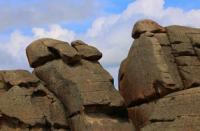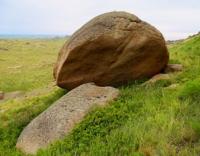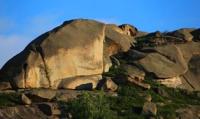You are here
Granite massif Aiyrtau on Altai.



Tours to mountains Kazakhstan Altai.
“We don’t notice the air, but we choke without it. So it is with wildlife. Only when we lose it completely, then we realize that we have lost..."
Nikolay Sladkov.
A trip from Ust-Kamenogorsk to Kalbatau.
A small isolated Aiyrtau granite massif resulting from long-term weathering of mattress-like slabs made of granite or granodiaorite is located in the Ulan region of the East Kazakhstan region, 47 kilometers southwest of Ust-Kamenogorsk in the northern part of the Kalba mountain range.
The highest height of the massif is Mount Aiyrtau, with a height of 1003 meters and sea level. The length of the granite massif from the southwest of the peasant farm Sartymbet and northeast is 8 kilometers. The greatest width in the vicinity of Mount Ayrtau is 3 kilometers.
The main attractions of the massif are granite cone-shaped outliers with a height of 5 to 21 meters towering in the northwest of the Kalbatau-Ust-Kamenogorsk highway. In the southwestern part of the massif is Lake Aiyr, 1,600 meters long and 914 meters wide.
A small lake is located in the northwestern part of the massif. In the northern part of the massif, a small stream of Shechekty flows from the springs, which is the left tributary of the Ulanka river. In the western part of the Aiyrtau granite massif there is the Kanaysky Log tract confined to the valley of the Uzunbulak river.
A little further to the west of the Kanaysky Log tract is the Zhanauz hill 697 meters above sea level. In the south of Ayrtau rises Mount Zhangyztas with a height of 666 meters above sea level. The granite massif of the Aiyrtau rock, which remained after the destruction of the more unstable rock surrounding it, in the process of weathering, erosion, and the influence of climatic conditions.
Granite outcrops are usually found among the forest and only occasionally exceed the level of surrounding trees in height. Granites refers to the durable types of stone, but it is also subject to processes of physical, chemical and biogenic weathering.
The dominant three granite remnants have the local name "Three Monasteries". In the rocky depressions of the Aiyrtau granite massif, between the peaks are small lakes with rainwater.
Authority and photos:
Alexander Petrov.







